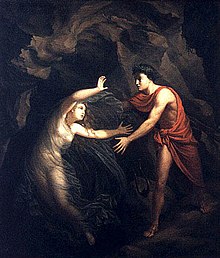Eurydice
oooooooooooooooookkInsert non-formatted text here


Eurydice (Εὐρυδίκη, Eurydíkē) (yur-ID-ih-see) in Greek mythology, was an oak nymph or one of the daughters of Apollo (the god of light). She was the wife of Orpheus. Orpheus loved her dearly; on their wedding day, Orpheus played songs filled with happiness as his bride danced through the meadow. One day, a satyr saw and pursued her. Eurydice stepped on a snake and fell to the ground. The venomous snake had bitten her, leaving Eurydice dead. Distraught, Orpheus played and sang so mournfully that all the nymphs and gods wept. In their saddened states, they told him to travel to the Underworld and retrieve her. Orpheus did so, and by his music softened the hearts of Hades and Persephone, his singing so sweet that even the Erinyes wept. In another version, Orpheus played his lyre to put the guardian of Hades, Cerberus, to sleep. It was then granted that Eurydice be allowed to return with him to the world of the living. But the condition was attached that he should walk in front of her and not look back until both had reached the upper world. Nevertheless, Orpheus in his passion for her, and just at the portals of Hades when they had reached daylight and climbed up all through hell together, could not help but turn around to gaze on her face. Eurydice then vanished again from his sight—this time forever.
The story in this form belongs to the time of Virgil, who first introduces the authorial name of Aristaeus in his work Georgics (29BC). Other ancient writers, however, speak of Orpheus' visit to the underworld; according to Phaedrus in Plato's Symposium, the infernal gods only "presented an apparition" of Eurydice to him. Plato's Phaedrus also accuses Orpheus of cowardice for not being prepared to die for Eurydice; it is possible that Plato knew a significantly different legend.
The story of Eurydice has strong parallels to the Japanese myth of Izanami, as well as to the Mayan myth of Itzamna and Ix Chel, the Indian myth of Savitri and Satyavan, and the Akkadian/Sumerian myth of Inanna's descent to the underworld.
Works of art
The story of Orpheus and Eurydice has been depicted in a number of works by famous artists, including Titian, Peter Paul Rubens, Nicolas Poussin and recently Bracha Ettinger whose series Eurydice was exhibited in the Pompidou Centre, Paris (Face à l'Histoire, 1996); the Stedelijk Museum, Amsterdam (Kabinet, 1997) and The Royal Museum of Fine Arts, Antwerpen (Gorge(l), 2007) and has inspired ample writings in the fields of ethics, aesthetics, art and feminist theory. It has also been retold in an opera by Monteverdi, Jacopo Peri, C W Gluck, Yevstigney Fomin and Harrison Birtwistle, a play by Sarah Ruhl, and in the comic book The Sandman by Neil Gaiman. It also forms the basis for the 1967 song "From the Underworld" by The Herd, and the poem "The Years Go Fast and the Days Go Slow" by James McCoy. "Eurydice (don't follow)" is also a song by the band The Cruxshadows. The music project Sleepthief includes "Eurydice" on their first album "The Dawnseeker." The myth of Orpheus and Eurydice features prominently in the 1967 album Reflections by Manos Hadjidakis and The New York Rock and Roll Ensemble in "Orpheus", the first song of the album. The freeware game Don't Look Back is a modern interpretation of the story.
See also
- List of characters in Metamorphoses
- Valsa de Euridice, a song by Vinicius de Moraes
- Euridice, an opera by Jacopo Peri
- Orphée, directed by Jean Cocteau (1949),
- Orfeo ed Euridice, an opera by Christoph Willibald Gluck
- Eurydice, a play by Sarah Ruhl
- Orfeu Negro, a 1959 adaptation of the classic myth, filmed in Brazil
- L'Orfeo, the earliest extant opera, from 1607, by Monteverdi
- The Lyre of Orpheus (album), an album by Nick Cave and the Bad Seeds
- Orpheus, a song by Manos Hadjidakis and The New York Rock and Roll Ensemble
- Eurydice, a play by Jean Anouilh
- Euridice, a song from the album Moving Waves by Focus (band)
- The Eurydice Project, written by D.J. Whistler (2007)
References
- Ovid, Metamorphoses 10
- Apollodorus, The Library 1.3.2
- Pausanias, Description of Greece 9.30
- Virgil, Georgics 4.453
- Plato, Symposium
- Sleepthief,"Eurydice" featuring Jody Quine"
- Griselda Pollock, "Abandoned at the Mouth of Hell". In: Looking Back to the Future. G&B Arts. ISBN 90-5701-132-8.
- Judith Butler, "Bracha's Eurydice". In: Bracha Lichtenberg Ettinger: Eurydice Series. Edited by Catherine de Zegher and Brian Massumi. Drawing Papers n.24. The Drawing center, NY, 2001. Reprinted in: Theory, Culture and Society, 21(1), 2004. ISSN 0263-2764.
- Emmanuel Levinas in conversation with Bracha L. Ettinger, "What would Eurydice Say?" (1991-1993). Reprinted in 1997. Reprinted in Athena: Philosophical Studies, Volume 2, 2006. ISSN 1822-5047.
- Dorota Glowaka, "Lyotard and Eurydice". In: Margaret Grebowicz (ed.),Gender after Lyotard. NY: Suny Press, 2007. ISBN 978-0-7914-6956-9
- Christine Buci-Glucksmann, "Eurydice and her Doubles. Painting after Auschwitz", in: Artworking 1985-1999, Amsterdam: Ludion, 2000. ISBN 90-5544-283-6.
- Carol Ann Duffy, "Eurydice". In: The World's Wife. ISBN 9780330372220.
